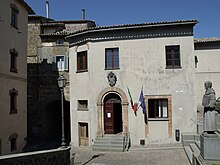Porano
| Porano | ||
|---|---|---|

|
|
|
| Country | Italy | |
| region | Umbria | |
| province | Terni (TR) | |
| Coordinates | 42 ° 41 ′ N , 12 ° 6 ′ E | |
| height | 444 m slm | |
| surface | 13.54 km² | |
| Residents | 1,910 (Dec. 31, 2019) | |
| Population density | 141 inhabitants / km² | |
| Post Code | 05010 | |
| prefix | 0763 | |
| ISTAT number | 055028 | |
| Popular name | Poranesi | |
| Patron saint |
San Biagio (February 3rd) |
|
| Website | www.comune.porano.tr.it | |
Porano is an Italian commune ( comune ) with 1910 inhabitants (as of December 31, 2019) in the province of Terni in the Umbria region .
geography
The community extends over around 14 km². It is located about 50 km southwest of Perugia and about 45 km northwest of Terni . The place is part of the Comunità montana Monte Peglia e Selva di Meana and has no other districts.
The neighboring municipalities are Lubriano ( VT ) and Orvieto .
history
The burial sites of the Etruscans in the municipality (approx. 2 km north between Orvieto and Porano) indicate an Etruscan site, but it was not until the 12th century that the main town emerged on the hill. The castrum (castle) is first documented in the 14th century, when the Orvieter family of Avveduti ran the place as a fief . At the beginning of the 15th century Ladislao d'Angiò conquered the place, which then remained under the rule of Orvieto with the nearby fortress Castel Rubello . At the end of the 16th century the place was integrated into the Papal States. The place remained there until 1860, when Umbria became a region of Italy as part of the Risorgimento . In 1927 the place was divided into the newly founded province of Terni.
Attractions
- Castel Rubello , castle from the 12th century
- Chiesa di San Biagio , a church documented as early as the 13th century . It contains a holy water font by Rutilio Laurenzi from 1608.
- Tomba degli Hescana , burial place of the Etruscans with wall paintings. Named after the Etruscan family of the Hescana. The tombs Golini I and II are also part of the complex, but were named after their discoverer. The paintings from these tombs have been transferred to the Museo archeologico di Orvieto .
Community partnerships
- Caudrot , Gironde department , France , since 1976
literature
- Touring Club Italiano : Umbria. Milan 1999, ISBN 88-365-2542-3 , p. 629.
Web links
- Official website of the Municipality of Porano (Italian)
- umbriatourism.it: Tomba degli Hescanas , pictures and interesting facts (German)
Individual evidence
- ↑ Statistiche demografiche ISTAT. Monthly population statistics of the Istituto Nazionale di Statistica , as of December 31 of 2019.
- ↑ umbriatravel.com: The Tombs of Golini and the Hescana , accessed on October 26, 2018 (German)


